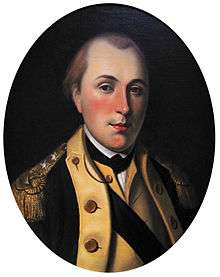Major general (United States)
In the United States Armed Forces, a major general is a two-star general officer in the United States Army, Marine Corps, Air Force, and Space Force.
| Major general | |
|---|---|
 Two-star insignia of the rank of major general. Style and method of wear may vary between different uniforms and different service branches. | |
| Country | |
| Service branch | |
| Abbreviation |
|
| Rank | Two-star |
| NATO rank | OF-7 |
| Non-NATO rank | O-8 |
| Next higher rank | Lieutenant general |
| Next lower rank | Brigadier general |
| Equivalent ranks |
|
A major general ranks above a brigadier general and below a lieutenant general.[Note 1] The pay grade of major general is O-8. It is equivalent to the rank of rear admiral in the other United States uniformed services which use naval ranks. It is abbreviated as MG in the Army, MajGen in the Marine Corps, and Maj Gen in the Air Force and Space Force.
Major general is the highest permanent peacetime rank in the uniformed services as higher ranks are technically temporary and linked to specific positions, although virtually all officers promoted to those ranks are approved to retire at their highest earned rank. A major general typically commands division-sized units of 10,000 to 15,000 soldiers.
Statutory limits






The United States Code explicitly limits the total number of general officers that may be on active duty at any given time. The total number of active duty general officers is capped at 231 for the Army, 62 for the Marine Corps, and 198 for the Air Force.[1] Some of these slots are reserved or finitely set by statute. For example, the Deputy Judge Advocate General of the Army[2] is a major general in the Army; the same rank is held by the Deputy Judge Advocate General of the Air Force;[3] the Army's Chief of Engineers[4] is also appointed as a major general and thereafter promoted to lieutenant general.
The United States Code also limits the total number of general officers that may be on the Reserve Active Status List (RASL) in the Reserve Component, which is defined in the case of general officers as the Army National Guard, Army Reserve, Marine Corps Reserve, Air National Guard, and Air Force Reserve.
Promotion, appointment, and tour length
To be promoted to the permanent grade of major general, officers who are eligible for promotion to this rank are screened by an in-service promotion board composed of other general officers from their branch of service.[5] This promotion board then generates a list of officers it recommends for promotion to general rank.[6] This list is then sent to the service secretary and the Joint Chiefs of Staff for review before it can be sent to the President, through the Secretary of Defense for consideration.[7] The President nominates officers to be promoted from this list with the advice of the Secretary of Defense, the service secretary, and if applicable, the service's chief of staff or commandant.[8] The President may nominate any eligible officer who is not on the recommended list if it serves in the interest of the nation, but this is uncommon. The Senate must then confirm the nominee by a majority vote before the officer can be promoted. Once confirmed, the nominee is promoted to that rank on assuming a position of office that requires an officer to hold the rank. For positions of office that are reserved by statute, the President nominates an officer for appointment to fill that position. For all three of the applicable uniformed services, because the grade of major general is a permanent rank, the nominee may still be screened by an in-service promotion board to add their input on the nominee before the nomination can be sent to the Senate for approval. Since the grade of major general is permanent, the rank does not expire when the officer vacates a two-star position. Tour length varies depending on the position, by statute, and/or when the officer receives a new assignment or a promotion, but the average tour length per two-star billet is two to four years.
In the Army, Major Generals (MG) typically serve as division commanders (e.g., infantry divisions, cavalry division, etc.), training center commanders, joint task force commanders, deputy commanding generals to 3-star generals, chief of staff in 4-star commands, senior directors on Army and joint staffs, and, in the case of the Army National Guard, as The Adjutant General (TAG) for their state, commonwealth or territory. In certain situations, states can promote their Adjutant General to general officer ranks without Senate confirmation. The officer will wear the general rank, yet only be recognized at their lower federally recognized rank. They're identified with the two letter state identifier of their respective National Guard being listed after their rank. Some examples of this are Major General (GA) Jim Butterworth and Major General (GU) Esther Aguigui.
In the Marine Corps, Major Generals (MajGen) typically serve as commanding generals or deputy commanding generals of Marine Expeditionary Forces, Marine Divisions, Marine Aircraft Wings, Joint Task Force Commanders, or senior directors on Marine Corps and joint staffs.
In the Air Force, Major Generals (Maj Gen) typically serve as Numbered Air Force commanders, vice commanders of 3-star commands, joint task force commanders, warfare center, training center, weapons center, or logistics center commanders, or senior directors on Air Force and joint staffs. In the case of the Air National Guard, they may also serve as The Adjutant General (TAG) for their state, commonwealth or territory.
Retirement
Other than voluntary retirement, statute sets a number of mandates for retirement of general officers (called flag officers in the Navy and Coast Guard). All major generals must retire after five years in grade or 35 years of service, whichever is later, unless appointed for promotion or reappointed to grade to serve longer.[9] Otherwise, all general officers must retire the month after their 64th birthday.[10]
History

U.S. Army
The Continental Army was established on June 15, 1775 when the Continental Congress commissioned George Washington as a general and placed him in command of the Army of Observation then besieging Boston. The rank of major general was first established two days later on June 17, 1775 when two major generals were commissioned by Congress soon followed by two more major generals being appointed on June 19.
Following the disbanding of the Continental Army at the end of 1783 only one major general, Henry Knox, remained in service until his resignation in June 1784. The rank was revived on March 4, 1791 when Arthur St. Clair was appointed as major general in command of the U.S. Army. St. Clair was succeeded by Major General Anthony Wayne who commanded the Army (then named the Legion of the United States) until his death on December 15, 1796. The rank was revived on July 19, 1798 when Alexander Hamilton and Charles C. Pinckney were commissioned as major generals during the Quasi War with France. The expanded Army was demobilized on June 15, 1800 when it was reduced to only four regiments of infantry and two of artillery commanded by a brigadier general.
The rank of major general was abolished in the U.S. Army by the Act of March 16, 1802,[11] and restored by the Act of January 11, 1812,[12] as preparations were being made for the War of 1812. Major general has been a rank in the U.S. Army ever since.
Until the American Civil War, major general was the highest rank that could be attained by an officer in the U.S. Army, though Winfield Scott had been given the brevet rank of lieutenant general[13] in 1855. This was a consequence of the fact that at his death George Washington was officially listed as holding the rank of lieutenant general, rather than full general, and it was regarded as improper for an officer to hold a rank equal to or superior to Washington's. To address this anomaly, Washington was posthumously promoted by Congress to the rank of General of the Armies of the United States in 1976.
The position of Major General Commanding the Army was entitled to wear three stars according to General Order No. 6 of March 13, 1861.[14] When Ulysses S. Grant was appointed lieutenant general on March 9, 1864,[15] and took command of the Union forces, he used the three-star insignia formerly assigned to that position.
Confederate States Army
The Confederate States Army maintained a similar rank of major general, usually associated with the command of a division, while lieutenant generals often commanded corps and full generals led armies as a general convention.
U.S. Marine Corps
There was no major general in the U.S. Marine Corps until Commandant Charles Heywood was specially promoted by Act of Congress in July 1902. From his retirement on October 3, 1903, brigadier general was again the highest rank in the Marine Corps until May 21, 1908, when the rank held by the commandant was raised to major general. It remained the highest rank in the Marine Corps until January 20, 1942, when the rank held by the commandant was raised to lieutenant general.
U.S. Air Force
Given that the U.S. Air Force evolved from its predecessors, the U.S. Army Air Service, the U.S. Army Air Corps and the U.S. Army Air Forces, the rank of major general in the Air Force coincides with its establishment as an independent service in 1947.
See also
| Wikimedia Commons has media related to Generals of the United States. |
- List of major generals in the United States Regular Army before July 1, 1920
- List of United States military leaders by rank
- United States Air Force officer rank insignia
- United States Army officer rank insignia
- United States Marine Corps officer rank insignia
- United States Navy officer rank insignia
References
- 10 USC § 526. Authorized strength: general and flag officers on active duty
- 10 USC 3037 Judge Advocate General, Assistant Judge Advocate General, and general officers of Judge Advocate General's Corps: appointment; duties
- 10 USC 8037 Judge Advocate General, Deputy Judge Advocate General: appointment; duties
- 10 USC 3036 Chiefs of branches: appointment; duties
- 10 USC 611 Convening of selection boards
- 10 USC 616 Recommendations for promotion by selection boards
- 10 USC 618 Action on reports of selection boards
- 10 USC 624 Promotions: how made
- 10 USC 636 Archived 2009-02-24 at the Wayback Machine Retirement for years of service: regular officers in grades above brigadier general and rear admiral (lower half)
- 10 USC 1253 Archived 2015-11-01 at the Wayback Machine Age 64: regular commissioned officers in general and flag officer grades; exception
- "Act of March 16, 1802, ch. 9, 2 Stat. 132". Archived from the original on 2017-06-27. Retrieved 2018-09-14.
- "Act of January 11, 1812, ch. 14, 2 Stat. 671". Archived from the original on 2017-06-27. Retrieved 2018-09-14.
- Foote, p 918
- General Order No. 6 Archived 2008-02-15 at the Wayback Machine Regulations for the Uniform and Dress of the Army of the United States 1861
- Boatner, p 353
Notes
- The rank of Major General originally began as Sergeant Major General and was junior to the rank of Lieutenant General. Over time, "Sergeant" was dropped and by the late 17th/early 18th century it had been shortened to Major General. As a result, the rank of Lieutenant General continues to be senior to Major General, even though the rank of Major has always been senior to the rank of Lieutenant.